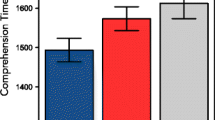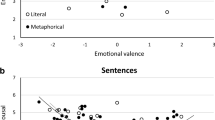Abstract
Three experiments investigated the role of authorial intentions in metaphor comprehension. In these studies, subjects read metaphoric (e.g., “A family album is like a museum”), literal (e.g., “An art gallery is like a museum”), and anomalous (e.g., “A tortoise shell is like an art gallery”) comparisons and rated their degreeof meaningfulness (Experiment 1), made speeded decisions as to whether each phrase was meaningful or not (Experiment 2), or wrote out interpretations of each comparison statement (Experiment 3). The subjects were tolt that the comparisons were written either by famous 20th century poets or by a computer program that randomly generated the statements from a list of words. Our general hypothesis was that knowing that intentional agents (the poets) authored the different comparisons should facilitate subjects' comprehension of the metaphors. Experiment 1 showed that subjects rated both metaphoric and literal comparisons as being more meaningful in the poet condition than when these statements were supposedly written by computer. Experiment 2 demonstrated that subjects were faster in making their meaningfulness judgments for metaphors in the poet condition than in the computer context, but that subjects were also slower in rejecting anomalous comparisons when these were supposedly written by the poets. Experiment 3 indicated that subjects produced more meanings or interpretations for comparisons presumably written by poets than by computer. These results highlight the improtance of implied, authorial intentions in understanding metaphorical statements. We discuss the implications of this work for psycholinguistic theories of figurative language comprehension, as well as for theories of literary interpretation.
Similar content being viewed by others
References
Barthes, R. (1972). The death of the author. In S. Sears & G. Lord (Eds.),The discontinuous universe. (pp. 68–104). New York: Basic Books.
Bergmann, M. (1982). Metaphorical assertions.Philosophical Review, 91, 229–245.
Bickerton, D. (1969). Prolegomena to a linguistic theory of metaphor.Foundations of Language, 5, 34–52.
Boswell, D. (1986). Speaker's intentions: constraints on metaphor comprehension.Metaphor and Symbolic Activity, 1, 153–170.
Brooks, C. (1939). Metaphor and the tradition. In C. Brooks (Ed.),Modern poetry and the tradition. Chapel Hill: University of North Carolina Press.
Clark, H., & Carlson, T. (1981). Context for comprehension. In J. Long & A. Baddeley (Eds.),Attention and performance, IX. (pp. 313–330). Hillsdale, NJ: Erlbaum.
Clark, H., & Haviland, S. (1977). Comprehension and the given-new contract. In R. Freedle (Ed.),Discourse production and comprehension. (pp. 1–40). Norwood, NJ: Ablex.
Cohen, L. J. (1979). The semantics of metaphor. In A. Ortony (Ed.),Metaphor and thought. London: Cambridge University Press.
Derrida, J. (1974). White mythology: Metaphor in the text of philosophy.New Literary History, 6, 5–73.
Derrida, J. (1976).Of grammatology. Baltimore: Johns Hopkins University Press.
Derrida, J. (1978). The retrait of metaphor.Enclitic, 2, 5–34.
Foucault, M. (1979). What is an author? In J. Harari (Ed.),Textual strategies. Ithaca, NY: Cornell University Press.
Gentner, D., & Clement, C. (1988). Evidence for relational selectivity in the interpretation of analogy and metaphor. In G. Bower (Ed.),The psychology of learning and motivation: Vol. 22, (pp. 307–358). Orlando: Academic Press.
Gerrig, R., & Healy, A. (1983). Dual processes in metaphor understanding: Comprehension and appreciation.Journal of Experimental Psychology: Learning, Memory and Cognition, 9, 667–675.
Gibbs, R. (1984). Literal meaning and psychological theory.Cognitive Science, 8, 275–304.
Gibbs, R. (1987). What does it mean to say that a metaphor has been understood? In R. Haskell (Ed.),Cognition and symbolic structures: The psychology of metaphoric transformation, (pp. 31–48). Norwood, NJ: Ablex.
Gibbs, R., Nayak, N., & Cutting, C. (1989). How to kick the bucket and not decompose: Analyzability and idiom processing.Journal of Memory and Language, 28, 576–593.
Gibbs, R. (1990). On the process of understanding literary metaphor.Journal of Literary Semantics, 14, 65–79.
Gildea, P., & Glucksberg, S. (1983). On understanding metaphor: The role of context.Journal of Verbal Learning and Verbal Behavior, 22, 577–591.
Grice, H. P. (1957). Meaning.Philosophical Review, 66, 377–388.
Grice, H. P. (1975). Logic and conversation. In P. Cole & J. Morgan (Eds.),Syntax and semantics 3: Speech acts. (pp. 41–58). New York: Academic Press.
Harris, R. (1976). Comprehension of metaphors: A test of the two stage processing model.Bulletin of the Psychonomic Society, 8, 312–314.
Hirsch, E. (1967).Validity in interpretation. New Haven: Yale University Press.
Hirsch, E. (1976).The aims of interpretation. Chicago: University of Chicago Press.
Hoffman, R., & Honeck, R. (1979). She laughed his joy and she cried his grief: Psycholinguistic theory and anomaly.Psychological Record, 29, 321–328.
Hoffman, R., & Kemper, S. (1987). What can reaction-time studies tell us about metaphor comprehension?Metaphor and Symbolic Activity, 2, 149–186.
Inhoff, A., Carroll, P., & Lima, S. (1984). Contextual effects on metaphor comprehension in reading.Memory and Cognition, 12, 558–567.
Kates, C. (1980).Pragmatics and semantics. Ithaca, NY: Cornell University Press.
Katz, A. (1982). Metaphoric relationships: The role of feature saliency.Journal of Psycholinguistic Research, 11, 283–296.
Kittay, E. (1987).Metaphor: Its cognitive force and linguistic structure. London: Basil Blackwell.
Kanpp, S., & Michaels, W. (1985). Against theory. In W. Mitchell (Ed.),Against theory: Literary studies and the new pragmaticism. (pp. 11–30). Chicago: University of Chicago Press.
Levin, S. (1977).The semantics of metaphor. Baltimore: Johns Hopkins University Press.
Nayak, N. & Gibbs, R. (1990). Conceptual knowledge in the interpretation of idioms.Journal of Experimental Psychology: General, 119, 315–330.
Ortony, A. (1979). Beyond literal similarity.Psychological Review, 86, 161–180.
Ortony, A., Schallert, I., Reynolds, R., & Antos, S. (1978). Interpreting metaphors and idioms: Some effects of context on comprehension.Journal of Verbal Learning and Learning Behavior, 17, 465–477.
Ortony, A., Vondruska, R., Foss, M., & Jones, L. (1985). Salience, similes, and the asymmetry of similarity.Journal of Memory and Language, 24, 569–594.
Pollio, H., & Burns, B. (1977). The anomaly of anomaly.Journal of Psycholinguistic Research, 6, 247–260.
Searle, J. (1969).Speech acts: An essay in the philosophy of language. Cambridge, England: Cambridge University Press.
Searle, J. (1979). Metaphor. In A. Ortony (Ed.),Metaphor and thought. (pp. 92–123). Cambridge, England: Cambridge University Press.
Shinjo, M., & Myers, J. (1987). The role of context in metaphor comprehension.Journal of Memory and Language, 26, 226–241.
Stern, J. (1985). Metaphor as demonstrative.Journal of Philosophy, 82, 677–510.
Steinberg, D. (1972). Truth, amphigory, and the semantic interpretation of sentences.Journal of Experimental Psychology, 93, 217–218.
Wimsatt, W., & Beardsley, M. (1954).The verbal icon: Studies in the meaning of poetry. Lexington: University of Kentucky Press.
Wimsatt, W., & Brooks, C. (1957).Literary criticism: A short history. Chicago: University of Chicago Press.
Rights and permissions
About this article
Cite this article
Gibbs, R.W., Kushner, J.M. & Mills, W.R. Authorial intentions and metaphor comprehension. J Psycholinguist Res 20, 11–30 (1991). https://doi.org/10.1007/BF01076917
Accepted:
Issue Date:
DOI: https://doi.org/10.1007/BF01076917




